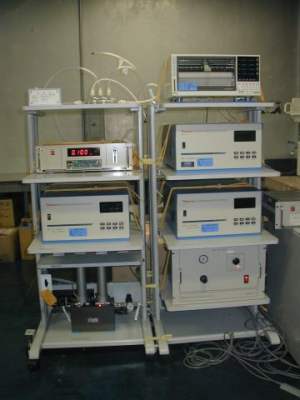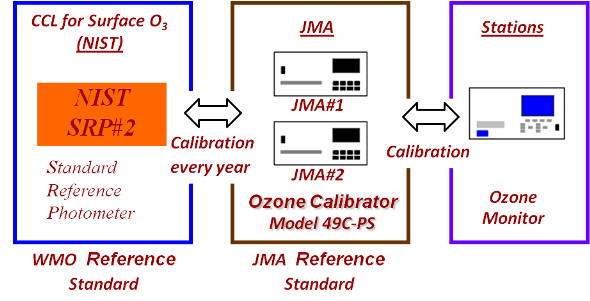Calibration for surface ozone observation
JMA operates a surface ozone calibration system (Figure 1) to maintain ozone monitoring equipment.
Background
JMA used a calibration system based on the potassium iodide (KI) method prescribed by JIS B7957 until March 2002 because there was no WMO-designated concentration standard for surface ozone observation. In this method, no comparison was made between ozone monitoring and calibration; rather, absolute concentration was determined via the calibration procedure itself. The approach also required additional preparation work, such as the formulation and accurate dilution of a KI solution, as well as special skills in analytical chemistry.
WMO adopted a standard reference photometer with an optical method featuring favorable stability and minimal error as developed by the National Institute of Standards and Technology (NIST) as the standard for surface ozone observation under the GAW programme. Subsequently, NIST was designated as the Central Calibration Laboratory for maintaining the standard for GAW surface ozone observation in the GAW Strategic Plan (WMO, 2001) .
In March 2002, JMA upgraded its calibration system for surface ozone to comply with the WMO standards, and started calibration utilizing an optical method involving comparison of operational ozone monitoring with the standard reference (*1) .
Surface ozone calibration system
Calibration architecture
The new calibration system used by JMA involves the use of a Model 49C-PS ozone calibrator (Nippon Thermo Co. Ltd.) with a calibration precision of 1 ppb, linearity not exceeding ±0.1% (full scale) , and a response speed of 20 seconds (up to 95%) . The ozone calibrator is sent to NIST on a regular basis for comparison with the WMO standard (Figure 2) . The traceability of the surface ozone calibration system is maintained to the WMO standard scale through this process.
Calibration procedure
Ozone monitors to be used at individual stations are calibrated using the new system as described below.
- Ozone-free gas is produced from the zero-air gas generator.
- Using this gas, four ozone standard concentrations (0, 150, 100 and 50 ppb) are produced sequentially using a 49C-PS ozone calibrator and fed into the ozone monitor to be calibrated.
- The concentrations are measured for 15 minutes after allowing 5 minutes for replacement. This calibration cycle is repeated ten times for the above four concentrations.
- Concentration is measured every ten seconds, mean concentrations and standard deviations for the 49C-PS ozone calibrator and the ozone monitor are calculated for each of the prescribed concentrations, and calibration coefficients are obtained for each cycle.
- After calibration measurement is complete, the ten calibration coefficients are averaged to obtain the calibration coefficient for the ozone monitor.
Ozone monitor operation after calibration
Ozone monitors calibrated at JMA Headquarters are sent to individual stations. After about six months of use in observation at stations, the units are sent back to JMA Headquarters and recalibrated to check for calibration coefficient changes. Consumable parts such as mercury lamps are then replaced, maintenance is carried out and the monitors are put on standby until the next observation. At the stations, two ozone monitors are operated in parallel for about a month to ensure appropriate observation when ozone monitors are replaced.
Note *1)
As the standard scales differ between the new and old calibration systems, the calibration coefficients were adjusted for mutual consistency. Data obtained at the three JMA observation stations were also corrected to ensure continuity (JMA 2004) .
|
Figure 1: Surface ozone calibration system at JMA headquarters |
|
Figure 2: JMA Calibration architecture for Surface ozone |
References
WMO, 2001: Strategy for the Implementation of the Global Atmosphere Watch Programme (2001-2007) . GAW Report No. 142, 62pp.

